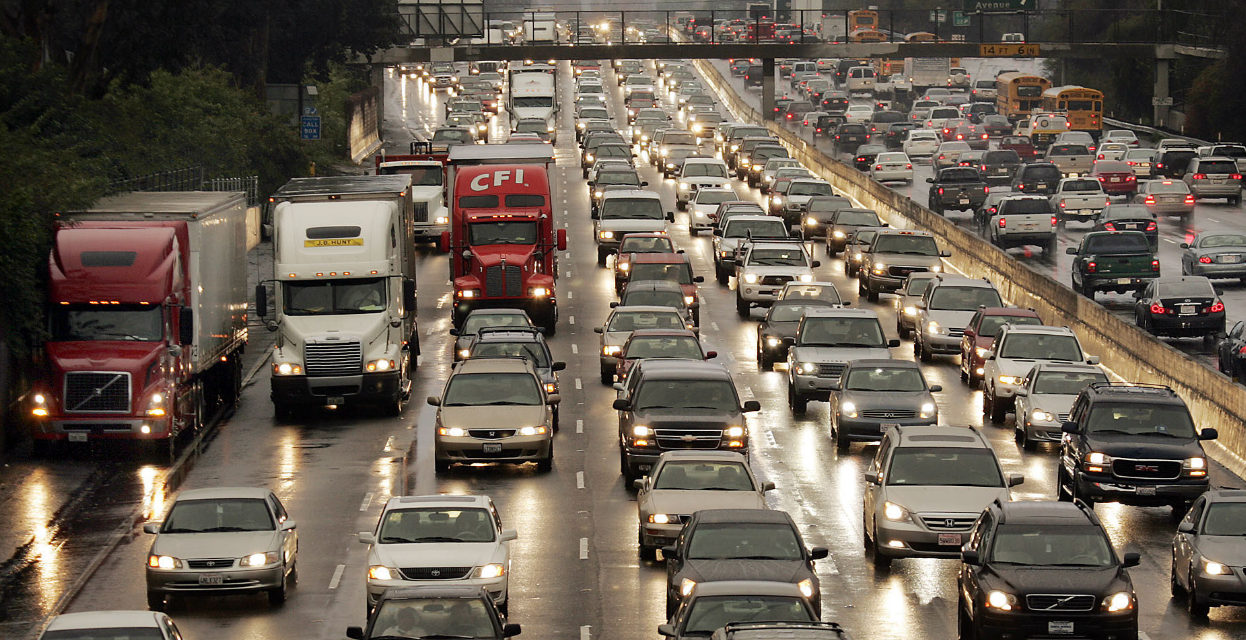We all know, deep down, that there is value to travel. Seeing not just the sights and eating strange new foods…but watching how people live. That’s the real “gold” that’s out there, waiting to be found. Sometimes, we don’t even know we’ve found it until we return home.
“Did you rent a car?”
That simple and all-too-American question caught me entirely off guard. “Oh, God. No!” My surprise was reflected in the raised eyebrow of my casual interviewer. “Who would want to rent a car in Denmark?” The incredulous words fanned a spark of an idea into a flickering flame, as they left my lips.
That was the moment when I saw, for the first time, that America has a HUGE mass transit system. Only, it’s not made up of multiple-passenger vehicles (trains, light rail, metro lines and buses). No, the American mass transit system (which may be the largest in the world) is almost entirely made up of individually owned vehicles.
Most people casually define a mass transit system as: “A system of tax & user-fee funded vehicles running on a pre-described route on a regularly timed schedule with a driver to passenger ratio that is quite high (1 to 30 per bus, 1 to 300 for a metro line, maybe 1 to 1,000 for a train), etc.”
I propose, for the sake of conversation, that we reframe our concept of a “mass transit system” to “that system which moves humans about.”
The need to move humans from here to there is, perhaps, one of the most important issues of our time. Yet, in America, the conversation about how best to do this has become stymied by multiple variables. Not the least of which is the profitability of the current system.
Where there is money to be made, there are minds to change, ideas to cultivate, emotions to manipulate, fears to feed and beliefs to plant. Basically, our purchasing choices are being hunted, and for over a century, corporations have employed the combined efforts of sociologists, psychologists and advertising specialists to do that and more. Their ultimate goal is to also control the political landscape, and, in this, they have succeeded.
The result? Americans are actually paying more money for what can quantifiably be defined as the worst transportation system of any “advanced” society on Earth, and they’re happy about it.
Across America, the individually owned vehicle is perceived (and presented) as a symbol of freedom, status and independence. Ridiculous car commercials showing beautiful, healthy and calm drivers traversing upscale city streets devoid of any other forms of life (animal, human or vehicular) ricochet across our television screens with mind-numbing frequency. The result? We buy into the fantasy. Hook, line and sinker or…as may be more appropriate…gas bill, insurance bill and maintenance bill.
And what do we get in return?
Not nearly as much as we are promised. Comparatively, a mass transit system made up of individually owned vehicles is less safe, economically less efficient, environmentally more polluting, entails greater travel time (not less), must be replaced more often (is less resilient as an infrastructure), is actually much less convenient, and generally results is a lower quality of life for the people that use it. The only reason this strategy hasn’t gone the way of the dinosaurs is that it’s the only option we have. By gutting our political will to support publicly-funded systems of transportation (trains, metro, light rail and significant bus routes), the impossible has been made possible: Americans actually prefer the worse option.
In Denmark, they have the better option. Since the 1970’s, three generations of Danes have said, “Yes, Yes, Yes!” to a tax-funded system of trains, metro, light rail and buses. The results? You would NEVER want to rent a car, when visiting Denmark and, if you’re lucky enough to live there, your family might own one car…maybe…but two? Highly unlikely. In fact, a significant portion of the country prefers a carless existence.
Based upon my calculations, the average American contributes $5,000 a year to the “commuter car mass transit system.” The average Dane appears to pay about $925 more (in taxes and user fees) per year, for the pleasure of a wide-flung, reliable and extremely frequent system of trains, metro, light rail and buses. Yet, most Danes celebrate their good fortune. After all, who wouldn’t pay $925, to get back 200-300 hours spent in relentless rush hour traffic…every year?
In short, America’s system of “mass transportation via individually owned vehicles” is:
More expensive
More accident-prone
Less healthy
More stressful
Doubles or triples commute times
Reduces overall happiness
And consumes huge swaths of land, devoted to freeways which (during rush hours) better resemble a parking lot.
More expensive
More accident-prone
Less healthy
More stressful
Doubles or triples commute times
Reduces overall happiness
And consumes huge swaths of land, devoted to freeways which (during rush hours) better resemble a parking lot.
Over the past year, as Americans have toyed with the idea of “doing things better,” I have often been the first to say, “There is no such thing as free lunch, free education, free medical care, or free anything!” Everything costs. Including all forms of transportation. The question we need to answer is: “How much does it cost, and which system gives us the most for our hard-earned buck?”
When Americans say “less taxes,” they often forget to follow that up with, “more individual out-of-pocket expenses.” America’s mass transit system (comprised of individual vehicles) may not raise our taxes, but it drains us of funds, health and energy on a daily basis. The sooner we accept the fact that some systems are better off being funded by taxes, the sooner we can begin the important work of evaluating (with a clear head) which is which. One way or another, everything is getting paid for and I’d like to believe that Americans are capable of choosing the more fiscally sound & environmentally sustainable option…whatever it might be.
Why do we appear to be stuck in an endless argument that leads to no new solutions? I suppose it might have something to do with (1) discouragement of citizen involvement, (2) well-funded lobbyists, (3) lack of campaign finance reform, (4) an increasingly under-educated population, and (5) the financial interests of those who profit from the current system.
All of which are reasons to read up on Bernie Sanders’ Campaign Platform and to get involved. Right now. Today. Change is always hard. But, in 2016, not changing is the choice that will hurt the most.


I’ve been browsing online greater than three hours as of
late, yet I by no means discovered any interesting article like yours.
It is beautiful value sufficient for me. Personally, if all webmasters and bloggers
made just right content material as you probably did, the web might be a
lot more helpful than ever before. http://bing.co.uk
Hi John! Thank you and I’m sure there is good content out there, amidst the “interesting” content, yes? I am happy that you are responding to my “America Has a HUGE Mass Transit System” article, as I worry that my past articles will be largely missed. Curious to know what you liked about this one, specifically? Do you have any insights that you’d like to add to the conversation?